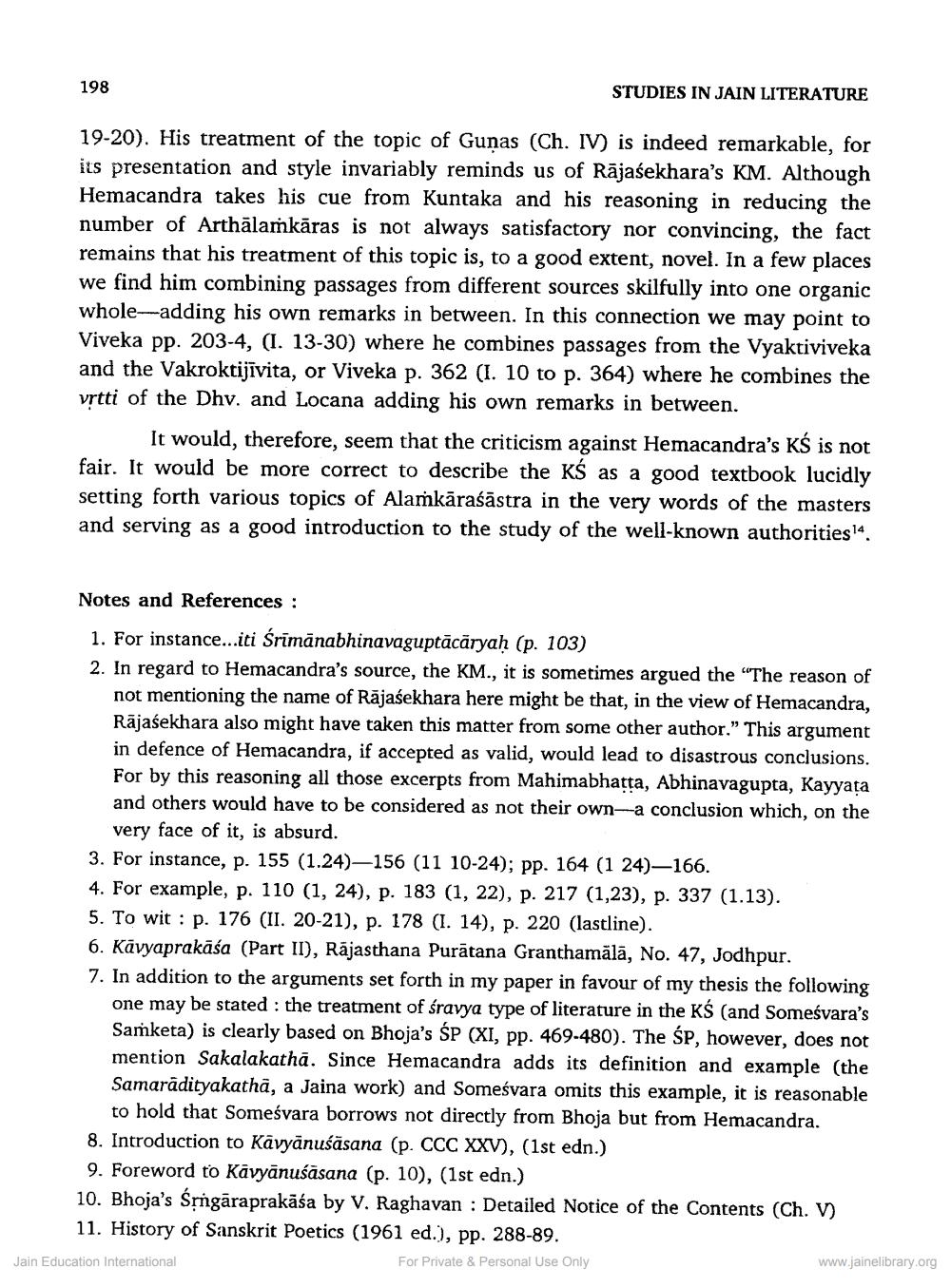________________ 198 STUDIES IN JAIN LITERATURE 19-20). His treatment of the topic of Gunas (Ch. IV) is indeed remarkable, for its presentation and style invariably reminds us of Rajasekhara's KM. Although Hemacandra takes his cue from Kuntaka and his reasoning in reducing the number of Arthalamkaras is not always satisfactory nor convincing, the fact remains that his treatment of this topic is, to a good extent, novel. In a few places we find him combining passages from different sources skilfully into one organic whole-adding his own remarks in between. In this connection we may point to Viveka pp. 203-4, (I. 13-30) where he combines passages from the Vyaktiviveka and the Vakroktijivita, or Viveka p. 362 (I. 10 to p. 364) where he combines the vrtti of the Dhv. and Locana adding his own remarks in between. It would, therefore, seem that the criticism against Hemacandra's KS is not fair. It would be more correct to describe the KS as a good textbook lucidly setting forth various topics of Alamkarasastra in the very words of the masters and serving as a good introduction to the study of the well-known authorities 14. Notes and References : 1. For instance...iti srimanabhinavaguptacaryah (p. 103) 2. In regard to Hemacandra's source, the KM., it is sometimes argued the "The reason of not mentioning the name of Rajasekhara here might be that, in the view of Heracandra, Rajasekhara also might have taken this matter from some other author." This argument in defence of Hemacandra, if accepted as valid, would lead to disastrous conclusions. For by this reasoning all those excerpts from Mahimabhatta, Abhinavagupta, Kayyata and others would have to be considered as not their own-a conclusion which, on the very face of it, is absurd. 3. For instance, p. 155 (1.24) 156 (11 10-24); pp. 164 (1 24)--166. 4. For example, p. 110 (1, 24), p. 183 (1, 22), p. 217 (1,23), p. 337 (1.13). 5. To wit : p. 176 (II. 20-21), p. 178 (I. 14), p. 220 (lastline). 6. Kavyaprakasa (Part II), Rajasthana Puratana Granthamala, No. 47, Jodhpur. 7. In addition to the arguments set forth in my paper in favour of my thesis the following one may be stated : the treatment of sravya type of literature in the KS (and Somesvara's Samketa) is clearly based on Bhoja's SP (XI, pp. 469-480). The SP, however, does not mention Sakalakatha. Since Hemacandra adds its definition and example (the Samaradityakatha, a Jaina work) and Somesvara omits this example, it is reasonable to hold that Somesvara borrows not directly from Bhoja but from Hemacandra. 8. Introduction to Kavyanusasana (p. CCC XXV), (1st edn.) 9. Foreword to Kavyanusasana (p. 10), (1st edn.) 10. Bhoja's Srngaraprakasa by V. Raghavan : Detailed Notice of the Contents (Ch. V) 11. History of Sanskrit Poetics (1961 ed.), pp. 288-89. Jain Education International For Private & Personal Use Only www.jainelibrary.org




